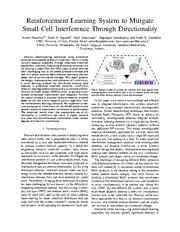Reinforcement learning system to mitigate small-cell interference through directionality
Anton Paatelma, Danh H. Nguyen, Harri Saarnisaari, Nagarajan Kandasamy, Kapil R. Dandekar
2017
2017 IEEE 28th Annual International Symposium on Personal, Indoor, and Mobile Radio Communications (PIMRC)
Fig. 1 : System model of a small-cell network with high spatial reuse through antenna directionality. BS1-5 are co-channel small-cell base stations (BSs) serving multiple clients synchronously In this paper we explore a low-overhead and efficient way to integrate directionality into wireless small-cell operations using compact, electronically reconfigurable antennas. Unlike beamforming techniques that employ multiple Radio Frequency (RF) chains to achieve directionality, reconfigurable antennas
more »
... integrate multiple miniature radiating elements on a single device, thereby producing several distinct radiation patterns without any additional RF circuitry. This makes reconfigurable antennas immediately applicable for use with client-side mobile devices, which usually have a single RF chain and can use only one antenna at a time. To make small-cell interference management practical with reconfigurable antennas, we propose LinkPursuit, a novel wireless network design that deploys reinforcement learning-based antenna state selection methods on top of a synchronous MAC protocol and adapts well to environmental changes. The challenge of designing efficient MAC protocols with directional antennas for wireless ad hoc networks has been well studied [2] . A substantial number of directional MAC protocols in the literature belong to the contentionbased, random access category. Our work focuses on building a directional MAC protocol that coordinates contention-free directional transmissions and receptions to occur simultaneously in an optimal way. Along this line, DIRC [3] and MiDAS [4] systems also explore multi-beam adaptive antenna systems for simultaneous transmissions in the same time slot. However, unlike ours, these approaches rely heavily on protocol coordination to assess and schedule antenna directions and are usually not resilient to intermittent environmental changes. Stochastic online learning using reinforcement learning algorithms has recently gained significant attention in Abstract-Beam-steering techniques using directional antennas are expected to play an important role in wireless network capacity expansion through ubiquitous small-cell deployment. However, integrating directional antennas into the existing wireless PHY and MAC stack of small cells has been challenging due to the added protocol overhead and lack of a robust antenna beam selection technique that can adapt well to environmental changes. This paper presents the design, implementation, and evaluation of LinkPursuit, a novel learning protocol for distributed antenna state selection in directional small-cell networks. LinkPursuit relies on reconfigurable antennas and a synchronous Time-Division Multiple Access (TDMA) MAC to achieve simultaneous directional transmission and reception. Further, the system employs a practical antenna selection protocol based on the well known adaptive pursuit algorithm from the reinforcement learning literature. We implement a realtime prototype of LinkPursuit on the WARP platform and conduct extensive experiments to evaluate its performance. The empirical results show that appropriate use of directionality in LinkPursuit can result in higher network sum rates than omnidirectional transmission under various degrees of cross-link interference.
doi:10.1109/pimrc.2017.8292393
dblp:conf/pimrc/PaatelmaNSKD17
fatcat:zpjtuhxumjbqveqq2c4kse3baq

